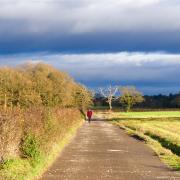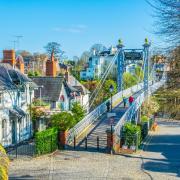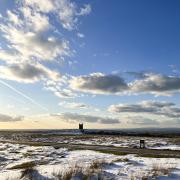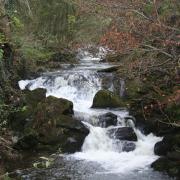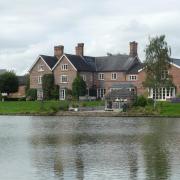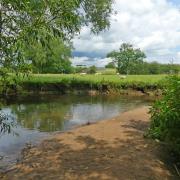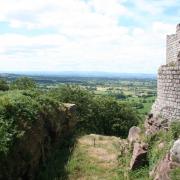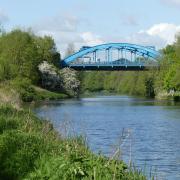To the north-eastern corner of Cheshire for a journey taking in industrial history, ancient countryside and one of the best pieces of canalscape in the county

Persistent local lore has it that a frustrated Agatha Christie chose the name of her spinster detective while stuck on a delayed train at Marple railway station. However, in 2015 her grandson Mathew Prichard was invited to an event to celebrate the 150th anniversary of the station and brought with him a letter that Christie had written to a fan, confirming the name Jane Marple was inspired by a visit to a furniture sale at the now-demolished Marple Hall, during a visit to her sister at Arley Hall.
Myths aside, there’s much to enjoy in this rugged north-eastern corner of historic Cheshire, close to the boundary with Derbyshire and now part of Greater Manchester. Brabyns Park, a large public space between the railway line and River Goyt, occupies the former grounds of Brabyns Hall, which was bought by the local authority from the Hudson family in 1941.
The dilapidated hall was demolished in 1952, but several elements of the estate survive, including the touching cemetery for the Hudsons’ numerous pets. Among the slabs recording the lives of treasured dogs and horses is a rather more unexpected memorial to Ben Lomond the seagull, who apparently delighted the family from 1897 to 1912.
Marple was an early centre of industry and the great cotton entrepreneur Samuel Oldknow was largely the man responsible. Oldknow’s enormous Mellor Mill, beside the River Goyt, burned down in a disastrous fire in 1892, but enough survives to give an impression of its huge proportions.

When I was last at the site, quietly eating my packed lunch on a convenient bench, I eavesdropped on an older gentleman explaining the workings of the mill and the purposes of the various bits and pieces of visible industrial archaeology to a young girl. Contrary to stereotype, she was listening engagedly and firing back intelligent questions at her grandfather. It was a small, chance moment, and the two of them probably thought nothing of it, but witnessing the two generations innocently enjoying each other’s company made my day.
Oldknow’s mill was originally water-powered, and the lakes dug to provide a head of water to the mighty wheels survive as the so-called Roman Lakes. The area was once a celebrated visitor attraction, but is now more low-key: the pretty sluice-keeper’s cottage no longer serves teas to day-trippers, and the Lakes complex is only open occasionally, or for private events.
From the bottom of the Goyt valley our route climbs via Roman Bridge (which is no more Roman than the nearby lakes are, but photogenic nevertheless) to the Peak Forest Canal for the return to Marple. The last quarter-mile, from the junction with the Macclesfield Canal, is one of the best pieces of canalscape in the county, featuring two characteristic ‘roving’ bridges near the meeting of the two canals, a series of locks and pounds at the top of the famous Marple Flight and a fine mill building.
Just off the route are the remains of Oldknow’s Gothick limekilns. In old photographs they look more like a grand medieval castle than a humble piece of industrial plant, though they have been considerably reduced by demolition. The area is maintained by The Friends of Oldknow’s Lime Kilns, with their rather nifty acronym FoLK. Talking of folk, it’s good to see the former Sportsman pub in Strines village re-opening as the Strines Nightingale – live music is high on their list of priorities.
1. From Brabyns Brow car park, cross the main road via a traffic island and head briefly into a corner of the park opposite to view the pets’ cemetery. When you’ve finished, return to the main road and head downhill. Beyond the car park, turn immediately right into the access road to the Midland pub. Take the higher, right-hand fork and then continue on a path at the end of the car park. This runs for half-a-mile between the River Goyt on your left and a rocky bank on your right, and passes a couple of disused adits used to drain mineshafts sunk in the higher ground to the west.
2. The path passes a gate into the grounds of the Garden House, a community farm. Walk along the top of the site and out via the driveway. Beyond the car park, turn left down to Bottoms Bridge and cross the River Goyt. Take time to explore the excavated remains of Mellor Mill in this area. To continue, follow Lakes Road, signposted to the Roman Lakes. Below Old Hall Farm (aka Bottom’s Hall), keep right, still following the signs to the Lakes. Pass the main Roman Lakes complex and continue below Goytcliffe Viaduct and past pretty Floodgates Cottage, alongside its weir.
3 By the next building, turn right and descend to Roman Bridge, an 18th-century packhorse bridge over a deep, rocky stretch of the Goyt. Cross the river and bear left, disregarding a path uphill to the right by a mounting block. Follow the lower path to a house, where you turn right and follow the driveway uphill to the B6101. (If visiting the Strines Nightingale, turn left and follow the narrow pavement for 300 metres, returning the same way.) Cross straight over into Plucksbridge Road and climb past the end of Barlow Wood Drive. When the road bends right, take a path straight on that climbs through the trees up to the Peak Forest Canal.

4. Turn right along the towpath, passing under bridge 21. Continue past bridge 20 (a footbridge) then at bridge 19 follow the spiral ramp and cross the bridge to the other side of the canal. Take the towpath once more, to the right of a house. The towpath leads shortly to the junction of the Peak Forest and Macclesfield Canals: join the road and turn right over bridge 1 of the Macclesfield Canal.
5. Follow the canalside road past the first four locks in the Marple Flight, numbered 16, 15, 14 and 13. (To visit Oldknow’s impressive limekiln, cross the bridge below lock 16.) After the four locks, pass under the B6101 via a sunken, horseshoe-arched tunnel. Keeping right of the steps, continue along the towpath past a further four locks (12, 11, 10, 9) and the impressive Lockside Mill until you reach the A626. Turn right and walk down the road, over the railway back to the station and Brabyns Brow.

The Strines Nightingale
Formerly the Sportsman Inn, the Strines Nightingale is a new venture in Strines village, midway round this route. The name was chosen when the new proprietors chanced on an old account of crowds visiting nearby woods to hear a singing Nightingale that took up unexpected residence in the summer of 1862.
When I spoke to him a couple of weeks before their ‘soft opening’ in September, co-owner Chris Slater was audibly excited to fill me in on the unfolding plans for the new venture. Chris and his partner Leigh also run the Rose & Monkey in Manchester’s lively Northern Quarter, and although the Strines Nightingale won’t be quite as music-driven as its urban sibling, they do plan to host live performances from folk, blue and jazz artists.
The outlet is free of tie and intends to exploit this advantage to represent a good mix of small independent brewers, among them Torrside, based in nearby New Mills, and Blackjack Brewery, a Northern-Quarter neighbour of the Rose & Monkey. The impressive-sounding drinks roster promises five hand-pumps and a ‘craft beer wall’.
In a nod to local industry, they will be serving a couple of house brews: C.P.A., described as 'a crisp 4% session pilsner lager' and named for the Calico Printers Association, who operated the nearby Strines Printworks, and Oldknows Best, a session cask ale honouring the famous local industrialist. The Strines Nightingale will also stock specialist bottled beers, Lucky Saint (a well-regarded alcohol-free lager) and award-winning coffees from West Yorkshire outfit Darkwood.
Although the need for kitchen renovations means their full menu won’t be unveiled until the New Year, Chris and Leigh hope to provide at least a limited food offering from the start, particularly at weekends. As well as the bar, they are opening a wine and food shop serving cakes, bread and the like, with a focus on local suppliers and the guarantee of a good choice for vegetarians and vegans.
For all their innovation, the new owners haven’t forgotten the pub’s heritage: traditionalists and past regulars will be relieved to hear they will still offer old-school favourite tipples and are keeping the snug and the two open fires.
Part of the vaults has been dedicated to the history of the Sportsman and its former licencees, with a display of memorabilia. I’m assured that walkers and dog-owners are very welcome. In these challenging times, you can only admire the optimism of Chris, Leigh and partner Fuchsia Summerfield, and wish them the best of luck in their new enterprise.
Compass Points
Area of walk: Marple Bridge
Start point: Brabyns Brow car park SK6 5DT (free) or Marple Railway Station
Distance: 3¾ miles/5.9 km
Time to allow: 2 hours
Map: OS Explorer OL1: Dark Peak area or 268: Wilmslow, Macclesfield & Congleton
Refreshments: Strines Nightingale strinesnightingale.com
The Midland midlandmarplebridge.co.uk 0161 427 2370
Practicalities: Mostly level and easy underfoot, apart from the climb between the river and canal. The Garden House community farm is closed on Mondays; Roman Lakes is open only on the last Sunday of the month (October 30). Marple station is on the Hope Valley (Manchester Piccadilly to New Mills Central) line.




